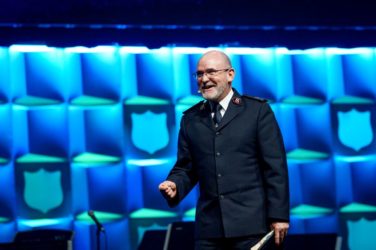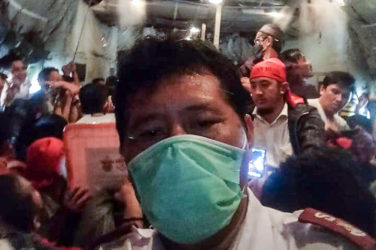Amateur “ham” radio operators have had a remarkable impact on the world during times of disasters thanks to SATERN (Salvation Army Team Emergency Radio Network). These trained volunteers are often the only link to the outside world during a disaster when cell phones are jammed or towers are down, land lines are damaged and electrical power is out.
1988-SATERN is the brainchild of then-Captain Patrick McPherson, a Salvation Army corps officer and the emergency disaster services (EDS) coordinator for the Heartland Division. The first network consists of Pat, EDS volunteer Arthur Evans and two Canadian Salvationists, Harold Gibson and Ernie Reid. Two months later, SATERN’s first international response occurs when Hurricane Gilbert batters the Caribbean for nine days, killing 341 people.
1990-Major Pat McPherson is named the Metropolitan Division’s EDS director. A week later, a horrific, F5 tornado hits Plainfield, Ill., killing 29 people and causing $200 million in damages. SATERN requires 64 operators daily for 11 days.
1993-Over 1,000 miles of Mississippi River flooding requires a multi-state SATERN response. A year later SATERN assists at the American Eagle airline crash in Indiana in which 68 lives are lost.
1995-A SATERN operator and Salvation Army canteen are sent to earthquake-stricken Kobe, Japan, where 5,500 are dead, 26,000 are injured.
1997-SATERN responds during the extensive Grand Forks flooding in North Dakota and Minnesota.
1998-During Hurricane Mitch, the Atlantic’s second deadliest, the Federal Communications Commission (FCC) designates SATERN’s radio frequency for official emergency use. Honduras and Nicaragua report 11,000 dead and 8,000 missing. SATERN becomes an official Salvation Army program and Major PatMcPherson is appointed its national director.
1999-A 7.9 earthquake strikes Turkey; over 300 aftershocks leave 14,000 dead, 200,000 homeless. An operator makes first-voice contact into Turkey, relays information to SATERN.
2001-SATERN springs into action on 9/11 as operators coordinate emergency responses. A SATERN North America Command is set up at Central Territorial Headquarters. Australian and German stations assist with “Stand by for America.”
SATERN facilitates EDS responses as wildfires engulf portions of western states. The National Association for Amateur Radio produces a video narrated by Walter Cronkite highlighting the disaster services work of The Salvation Army and SATERN.
2003-Major Rick Shirran, Bermuda corps officer and Canadian SATERN director relays data from the midst of Hurricane Fabian (he becomes U.S. SATERN director in 2011). A year later, four hurricanes blast Florida and the Bahamas; SATERN is nationally heralded for its person-location operations.
2005-Hurricanes Katrina and Rita hit the Gulf Coast leaving 1,800 dead and $81 billion in damages. International SATERN runs full force for 20 days. Operators save lives by directing emergency personnel to people trapped on rooftops. Over 61,000 person-location requests come in at a rate of 20 per second; amazingly, SATERN locates 25,508 people. An emergency call sign on a federal frequency is assigned to SATERN.
2007-The Department of Homeland Security assigns call signs to three SATERN administrators.
2008-With a membership of 3,700 trained operators, SATERN stands ready to serve at a moment’s notice. More than 40 net meetings are held weekly, along with frequent training classes, which are listened to by thousands more.
2010-SATERN continues to grow in response capabilities to disasters around the world, including the horrific earthquake that struck Haiti in January.
2011-Reports and articles on SATERN appear in major industry publications. Membership grows to more than 4,500 with countless thousands of world-wide operators willing to pitch in. A major SATERN response supports Joplin, Mo., tornado survivors and EDS operations. Major Rick Shirran, Canada and Bermuda Territory, is appointed the USA national liaison officer for SATERN.
2012-SATERN membership approaches 4,600 members. Three-day licensing courses and exams offered by SATERN in the Central Territory continue in popularity. Territories experiment with or institute digital high frequency networks.
2013-SATERN celebrates its 25th year with the introduction of new technologies and capabilities, plus a new commitment to cross-training SATERN members in EDS criteria. The FCC reports amateur “ham” radio operator licenses are at an all-time high in the U.S. with 760,000 licenses as entire families begin to take up ham radio as a hobby.




